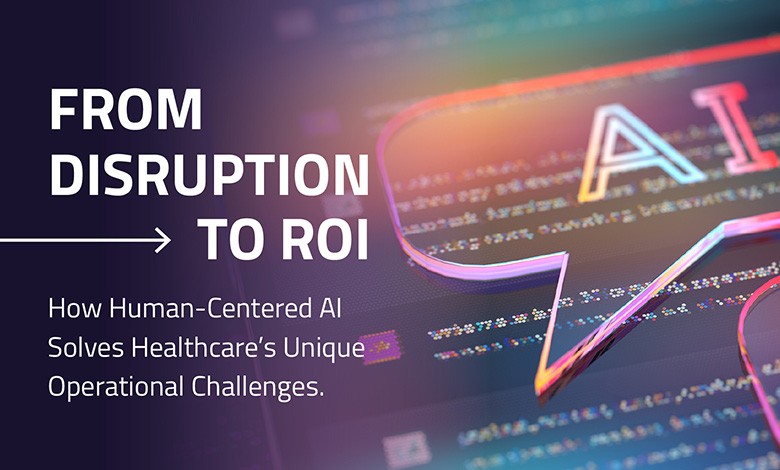
Healthcare has been promised AI miracles for years. Instead, many hospitals got more screens, more alerts, and more clinician burnout. Emergency physicians complain about telepresence robots that take longer to operate than the care they save. Nurses are overwhelmed by AI-powered notifications that don’t significantly reduce their workload. Administrators are stuck with costly pilots that never scale.
This isn’t technophobia. It’s a rational response to technology-first solutions that ignore healthcare’s operational reality.
But there’s a turning point emerging. When AI is designed to serve healthcare’s unique operational realities rather than impose external solutions, it’s proving capable of solving healthcare’s toughest challenges—all while retaining the human connection at the bedside.
Healthcare’s “Messy Middle” with AI
We’ve been here before.
When electronic health records were first introduced, clinicians feared screens would replace meaningful patient interactions. The transition was rocky, expensive, and deeply unpopular. But over time, EHRs prevented medication errors, improved care coordination, and became indispensable.
AI is in its own “messy middle”—still disruptive, still destabilizing workflows, still falling short of its promise. And like past transformations, the ones who succeed will design for augmentation, not automation.
Why Most AI Still Fails in Healthcare
Hospitals aren’t consumer tech companies. You can’t “move fast and break things” when lives are on the line.
Most healthcare AI fails because it:
- Adds work instead of removing it
- Generates alerts without actionable insight
- Forces new workflows instead of embedding into existing ones
- Creates IT burden and hidden costs with bolt-on tools
- Consumes bandwidth, time, and trust without delivering measurable ROI
Healthcare is an ecosystem of interdependent teams, regulations, and safety protocols. If AI doesn’t respect that, it creates friction instead of efficiency.
The cost of failed AI implementations extends beyond wasted budgets. When hospitals invest in systems that don’t deliver promised outcomes, it creates organizational skepticism that makes future innovation adoption more difficult. This “AI fatigue” is becoming a real barrier to meaningful progress, as clinical leaders become increasingly cautious about new technology promises.
What Works: Human-Centered AI That Fits the Way Hospitals Already Work
While many AI implementations fail to deliver on their promises, a new generation of healthcare AI is proving that technology can enhance rather than hinder clinical care.
The AI that works in hospitals today has three defining traits:
Human-Centered Design
Human-centered design means involving healthcare professionals from day one, understanding their actual workflows rather than idealized versions. The goal is augmentation that makes clinical work easier and more effective, not automation that attempts to replace human judgment in complex patient care decisions.
This approach creates what healthcare leaders call “hybrid workforce models”—flexible teams that blend remote specialists with on-site clinical staff. These models enable healthcare teams to scale their impact beyond physical limitations and provide other benefits, such as bringing specialists to underserved rural areas, extending careers for aging nurses, and mentoring new graduates remotely.
The key is designing AI that feels like a natural extension of clinical intuition rather than a foreign system requiring extensive training. When nurses can leverage AI insights without interrupting their patient interactions, the technology becomes invisible—exactly where it should be.
Workflow-Native Integration
Workflow-native integration requires sophisticated technical approaches that work within healthcare’s unique constraints. Edge computing addresses healthcare’s data privacy requirements by processing information locally rather than sending sensitive patient data to external cloud services. AI systems designed for healthcare must also handle variable network conditions and integration challenges common in hospital environments, building solutions that work reliably with existing infrastructure rather than requiring expensive technology upgrades.
The most successful implementations also prioritize interoperability, ensuring AI systems can communicate with multiple electronic health record platforms, communication tools, and medical devices without creating data silos. True integration means AI capabilities that work seamlessly with Epic, Cerner, and other EHR systems without requiring staff to toggle between multiple applications. It means alerts that appear directly in existing clinical workflows rather than creating new notification channels that compete for attention with existing systems.
Clear Economic Impact
The economic benefits extend beyond immediate cost reductions to fundamental workforce sustainability. Healthcare faces unprecedented pressure from aging populations, workforce shortages, and rising costs, creating opportunities for AI solutions that genuinely enhance efficiency rather than just automate existing processes. When AI enhances human monitoring capabilities and streamlines administrative coordination, it creates more sustainable working conditions and career paths for healthcare professionals.
More importantly, AI’s ability to identify patterns and predict potential problems before they occur transforms healthcare from reactive to proactive care delivery. The financial impact compounds because organizations solve workforce challenges and operational inefficiencies simultaneously, rather than managing separate point solutions that don’t integrate with existing workflows.
Beyond the Learning Curve
The messy middle is over. Hospitals can’t afford experiments that add work without delivering value.
The future is human-centered AI that:
- Pays for itself in months
- Frees hundreds of clinical hours every week
- Prevents sentinel events before they happen
- Retains nurses by reducing burnout and workload
- Delivers analytics, alerts, and integrations in one platform
Technology should serve clinicians, not the other way around.
Hospitals that embrace this shift will not only survive the staffing crisis but emerge stronger, more sustainable, safer, and more human.





